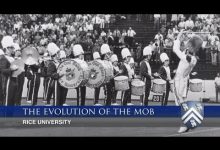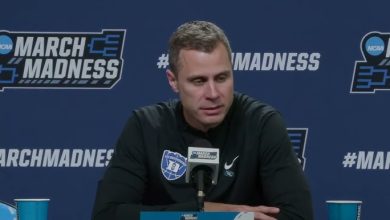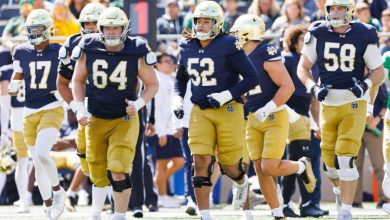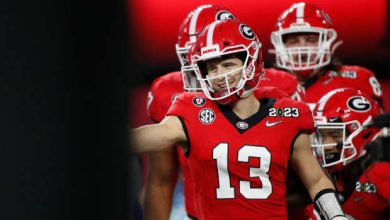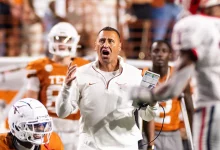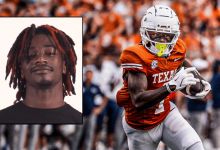Texas Longhorns wide receiver DeAndre Moore discussed the key differences between Arch Manning and Quinn Ewers during fall camp, highlighting their distinct playing styles and leadership qualities.
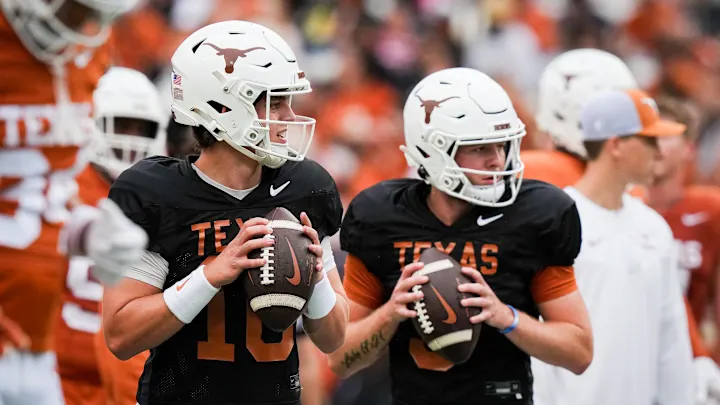
During the recent fall camp in Austin, Texas, Texas Longhorns wide receiver DeAndre Moore offered insightful perspectives on the notable differences between two of the team’s quarterback stalwarts, Arch Manning and Quinn Ewers. As an emerging figure in the team’s offensive unit, Moore’s observations shed light on the contrasting playing styles, leadership qualities, and overall impacts of these two talented signal-callers. His comments underscore the unique attributes each quarterback brings to the table, highlighting how their individual strengths shape the Longhorns’ offensive strategy and team dynamics.
Arch Manning, the grandson of Archie Manning and nephew of Peyton and Eli Manning, entered the Longhorns’ program with high expectations due to his storied football lineage and impressive high school career. Known for his exceptional football IQ, poise under pressure, and innate leadership qualities, Manning brings a cerebral approach to quarterbacking. His playing style is characterized by precise decision-making, excellent pocket awareness, and a calm demeanor that allows him to operate effectively under duress. Moore emphasizes Manning’s ability to read defenses pre-snap and his quick, accurate throws, which often result in extended drives and high-percentage completions. His leadership is evident through his calm presence on the field, his ability to command attention in the huddle, and his capacity to elevate the team’s confidence during critical moments.
Quinn Ewers, on the other hand, offers a different set of qualities that make him a formidable quarterback for the Longhorns. Ewers, a highly touted recruit with a strong arm and impressive athleticism, is known for his dynamic playmaking ability and aggressive style. Moore notes that Ewers’ playing style is more physical and risk-taking, often looking to stretch defenses with deep throws and improvisational plays. His arm strength allows him to make difficult throws downfield, and his athleticism enables him to extend plays outside the pocket. Ewers’ leadership manifests through his confidence and vocal presence, inspiring teammates with his aggressive approach and unwavering belief in his arm and decision-making capabilities.
Moore’s analysis highlights how these contrasting styles complement each other within the team’s offensive scheme. Manning’s methodical, calculated approach provides stability and consistency, especially in high-pressure situations where composure is vital. His ability to dissect defenses and deliver accurate passes allows the offense to maintain rhythm and control. Conversely, Ewers’ flair for the dramatic and his willingness to take risks injects a level of excitement and unpredictability into the attack, often leading to big plays and momentum shifts. The combination of these two quarterbacks offers the Longhorns a versatile offensive threat, capable of adapting to different game scenarios and defensive strategies.
Leadership qualities are another focal point of Moore’s discussion. Manning’s leadership is rooted in his calmness, discipline, and respect for the game. He exudes a quiet confidence that resonates with teammates, fostering a sense of trust and stability within the locker room. His approach to leadership is often through setting an example with his preparation, poise, and football intelligence. Moore recognizes Manning’s ability to remain composed even in challenging situations, which helps galvanize the team and instills confidence in the offensive unit. This steady leadership helps maintain focus and discipline, crucial during high-stakes games and tight situations.
Ewers, by contrast, is characterized by his vocal, energetic leadership style. Moore describes him as a player who naturally draws attention with his confidence and enthusiasm. Ewers’ proactive communication on the field and his willingness to motivate teammates through his actions and words create a charged atmosphere in practices and games. His leadership style is more extroverted, inspiring teammates through his aggressive play and relentless drive. Moore notes that Ewers’ confidence can be contagious, energizing the team and encouraging a fearless approach to the game. Both quarterbacks’ leadership styles serve distinct purposes, and their ability to inspire different facets of the team adds depth to Texas’s leadership corps.
Moore’s insights also touch upon how these differences influence team dynamics and offensive strategy. Manning’s cerebral approach ensures that the offense functions smoothly, especially in structured situations where precision and decision-making are paramount. His knack for reading defenses pre-snap and making quick, accurate throws helps execute the game plan with efficiency. Ewers, meanwhile, injects a level of unpredictability that can be leveraged to create explosive plays. His arm talent and improvisational skills can break down defenses and generate momentum swings, which are vital in close contests.
Furthermore, Moore emphasizes the importance of having both quarterbacks healthy and prepared to lead the team, as their contrasting styles provide strategic flexibility. The coaching staff can tailor their game plan based on the opponent, leveraging Manning’s consistency in controlled settings and Ewers’ ability to spark big plays when needed. This depth at the quarterback position offers the Longhorns a strategic advantage, allowing them to adapt to various game scenarios and capitalize on defenses’ weaknesses.
Moore also reflects on the developmental pathways of both quarterbacks. Manning’s growth has been marked by his maturity, understanding of the game, and ability to remain composed under pressure—traits that he has cultivated through experience and mentorship. His leadership has become more pronounced as he gains confidence and familiarity with the offensive system. Ewers, meanwhile, continues to refine his decision-making, aiming to balance his natural playmaking instincts with improved consistency and situational awareness. Moore highlights that both players are still evolving, and their distinct styles will continue to develop as they gain more game experience.
In addition to their individual qualities, Moore recognizes that both quarterbacks share a common drive to succeed and a commitment to team success. Their competitive nature and desire to lead the Longhorns to victories foster a healthy rivalry and camaraderie, which benefits the overall team environment. Their contrasting personalities and styles create a complementary dynamic that pushes each other to improve, ultimately elevating the entire team’s performance.
Moore’s detailed comparison underscores the broader strategic implications for the Longhorns’ offense and coaching philosophy. With two talented quarterbacks who excel in different aspects of the game, Texas can deploy flexible game plans that exploit defensive weaknesses and adapt to game flow. This versatility not only makes the offense more unpredictable but also positions the team to thrive in diverse situations, from grinding out tough victories with Manning’s precision to unleashing explosive plays with Ewers’ arm talent.
In conclusion, DeAndre Moore’s insights into the differences between Arch Manning and Quinn Ewers reveal a nuanced understanding of their unique playing styles and leadership qualities. Manning’s calm, cerebral approach offers stability, consistency, and quiet leadership, while Ewers’ energetic, risk-taking style brings explosiveness, confidence, and vocal motivation. Both players contribute distinct strengths that, when combined, provide the Texas Longhorns with a dynamic and adaptable offensive threat. As they continue to develop and refine their skills, their contrasting attributes will remain a valuable asset for the team’s success, offering strategic flexibility and inspiring leadership that can elevate the Longhorns to new heights in college football.

